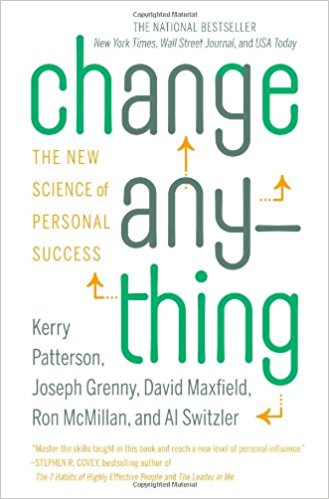“Everyone thinks of changing the world, but no one thinks of changing himself.”
-Leo Tolstoy
Every other spring, I teach an advanced organizational behavior class. Beyond the regular textbook, I require my students to read Patterson, Grenny, Maxfield, McMillan, and Switzler’s (2011) Change Anything: The New Science of Personal Success. I also require them to work through a semester-long change project following the book’s principles.
I require students to take on a change project that will last for about 3 months. It should be important enough to merit their time, difficult enough to stretch them, and manageable enough to be completed in three months. Most of them choose personal goal like losing weight or increasing savings. In my last class, students achieved some impressive results:
Eating right and losing weight:
- One student lost 8 pounds by eating right.
- Another student lost 10 pounds by eating right and playing more basketball.
- Another lost 17 pounds by eating right and exercising.
- Another lost 18.5 pounds by eating right and exercising.
- Another student lost 11 pounds by focusing on running more.
- Other health gains:
- One student lost three inches from his waistline.
- Another sedentary student walked 168 miles over the course of the semester.
- Another student lowered cholesterol from 233 mg/dl the first week to 120mg/dl at the end of the semester (it was measured by a doctor).
- Finances:
- One student wanted to double her savings from $2,000 to $4,000. She failed in her stated goal, but she had $3,700 in savings by the end of the semester. I consider that success.
- Another student was a compulsive shopper. She aggressively paid off much of her debt over the course of the semester. She created a budget, stopped all unnecessary spending, said “no” to every expenditure that was not necessary, renegotiated debt, cancelled credit card accounts, unsubscribed from all email marketing, and tracked every penny of every expenditure). By following this austere regimen, she paid off more than $10,000 during this class.
- Other activities:
- One student focused on being a better spouse (quantifying time and things done for her spouse).
- Another focused on improving study habits (quantifying grades including standardized test grades for a national exam).
- Another replaced television time with reading and exercise
- Others focused on taking on more activities at work and avoiding negativity at work (this is more difficult to track, but still possible)
A few key elements were involved in successful change efforts. First, my students had to have a clear plan for change. They could not say that they, “wanted to be healthy.” They could say, “I will forgo fast food and exercise 5 days a week for at least 45 minutes each day.”
Second, they had a support group. They were grouped in teams and they were required to check in regularly with their teams to update them about their progress. This was powerful and you can create a group that will support you every week at GBN. You will see the same people every week. Surely some of them want to change too. Why not support each other?
Finally, they tapped into all six sources of influence. I will talk about them next week, but if you want to know why you have failed at making changes in the past, consider the following. The authors wrote:
To see how your typical change effort takes form, consider the following metaphor. You’re rather large SUV runs out of gas a half block from a gas station—just over a gently cresting hill. You decide to push the beast to the nearest pump, but this isn’t your old, tinfoil based VW bug that you could easily push by yourself; it’s the Sherman tank of soccer moms. So you wave down a half dozen rather large and muscular strangers to help you. Each put in a full effort. Each grunts and strains and pushes against the massive bulk—one person at a time. In response, your SUV just sits there with a smug look on its grille.
Now, as hopeless as this sounds, it’s about to get worse. Imagine that in addition to the fact that the people assisting you are working in isolation rather than in combination, there are six hefty strangers all pushing together to propel your truck back down the hill. Now you have an accurate image of why your change attempt feels so overwhelming. Our problem is not just that we’re only using one source of influence at the time; it’s also that those who aren’t pushing for us are usually pushing against us. This is precisely why we fail in our attempts at personal change.[i]
What About You?
Are you interested in learning how to make a personal change?
In our next lesson, I will tell you how these gains were accomplished. I will cover each of the six sources of influence, and this will give you some time to think of what you want to change, find a few friends who also want to make changes, and get the book before the next lesson.
References
[i] Patterson, K., (2011). Change anything: The new science of personal success. New York: Business Plus. (pp. 10-11).
-Darin Gerdes
______________

Dr. Darin Gerdes is an Associate Professor of management in the School of Business at Charleston Southern University. All ideas expressed on www.daringerdes.com are his own.
This post was originally created for Great Business Networking (GBN), a networking organization for business professionals where Dr. Gerdes is the Director of Education.

